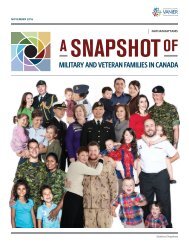1ee0ey1
1ee0ey1
1ee0ey1
You also want an ePaper? Increase the reach of your titles
YUMPU automatically turns print PDFs into web optimized ePapers that Google loves.
A HOMELESS HUB RESEARCH PAPER<br />
services. In many urban centres, Aboriginal-controlled<br />
service organizations that focused on capacity<br />
building and direct service provision were established<br />
(Abele and Graham 2011, Abele 2004). What currently<br />
exists in cities to support urban Aboriginal Peoples is<br />
largely a result of this era of change.<br />
Since this time, the Government of Canada has<br />
made funding commitments toward the housing<br />
and well-being of both reserve- and urbandwelling<br />
Aboriginal People. In 1999, the federal<br />
government implemented the $753 million National<br />
Homelessness Initiative (NHI; now Homeless<br />
Partnering Strategy), which was a three-year program<br />
designed alleviate homelessness across the country<br />
by funding a range of programs and services for<br />
homeless people (Belanger et al. 2012 b). Out of this<br />
funding, $59 million was dedicated to addressing<br />
urban Aboriginal homelessness (National Aboriginal<br />
Housing Association 2009). In recognition of the<br />
ever-escalating urban Aboriginal homelessness<br />
crisis in Canada, the federal government renewed<br />
the NHI in 2003, allocating $45 million to the<br />
National Homelessness Initiative through the Urban<br />
Aboriginal Homelessness (UAH) module (Belanger et<br />
al. 2012 b, Webster 2007).<br />
The dedication of homelessness funding for<br />
Aboriginal Peoples is viewed as a progressive step by<br />
some (Walker 2003). However, Aboriginal community<br />
initiatives have not always been adequately<br />
supported by such financial infusions. This fact is<br />
particularly difficult in urban centres like Toronto,<br />
where the Aboriginal population is in the hundreds<br />
of thousands, and does little to change the situation<br />
of inadequate on-reserve housing. As Webster (2007)<br />
points out, UAH funding intended for Aboriginal<br />
shelter clients was often received by non-Aboriginal<br />
shelters, which may have limited its impact on<br />
Aboriginal Peoples in need. The National Aboriginal<br />
Housing Association (2009) reports that the current<br />
funding extension under the Homeless Partnering<br />
Strategy (HPS) for 2009-2014 provides $134.8 million<br />
annually, with $14.6 million directed specifically to<br />
Aboriginal need. The HPS aims to prevent and reduce<br />
homelessness by providing support directly to 61<br />
designated communities, along with Aboriginal and<br />
rural/remote communities.<br />
The federally funded Urban Aboriginal Strategy<br />
(UAS), which began in 1998, endeavours to address<br />
the widening socio-economic gap between urbandwelling<br />
Aboriginal and non-Aboriginal people<br />
through policy improvements and program<br />
development (Walker 2005). The Government of<br />
Canada made a commitment to urban Aboriginal<br />
communities in the 2012 Budget by renewing the<br />
UAS and investing $27 million over two years (2012-13<br />
and 2013-14) to improve economic opportunities for<br />
Aboriginal Peoples living in urban centres (Aboriginal<br />
Affairs and Northern Development Canada 2013).<br />
However, Walker (2005:410) feels the problem of<br />
the UAS is it “is not based in the evolving Aboriginal<br />
rights of self-determination and self-government<br />
that are central to contemporary Aboriginality.”<br />
Walker (2005:397) defines ‘self-determination’ as “the<br />
inherent right of Aboriginal/Indigenous peoples<br />
to continue governing their own affairs.” He notes,<br />
within Canada, self-determination equates to the<br />
right of self-government 7 : administrative authority<br />
over the Aboriginal population lies within Aboriginal<br />
institutions (Walker 2005). Walker’s (2006) study<br />
of low-cost housing provision in Winnipeg found<br />
Aboriginal self-determination was not fully evident<br />
in cities, despite the fact that a majority of clients<br />
would be Aboriginal. The reality was almost none<br />
of the decision-making process took them into<br />
account. Many scholars and stakeholders dealing<br />
with this issue assert the way forward lies in<br />
Aboriginal self-determination (Abele and Graham<br />
2011, Walker 2008, Walker 2006, Walker 2005, Walker<br />
2003). Others, such as Crookshanks (2012), claim selfdetermination<br />
may not be fully possible in an urban<br />
setting, but believe the concept is productive insofar<br />
as it sets a normative goal for ending modern-day<br />
colonialism by calling for Aboriginal control over<br />
7. In contrast, Crookshanks (2012) contends self-determination amounts to the broader goal of autonomy, while self-government is<br />
the political manifestation of this pursuit.<br />
27





